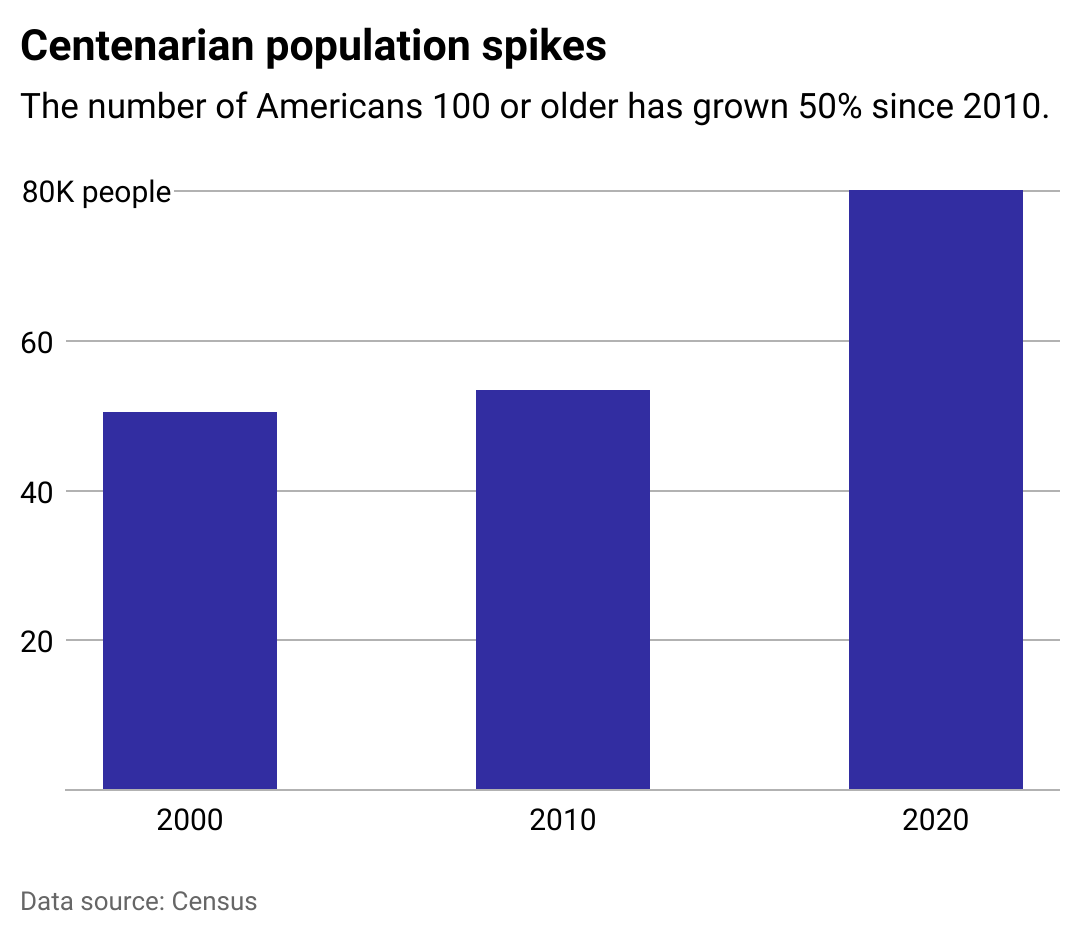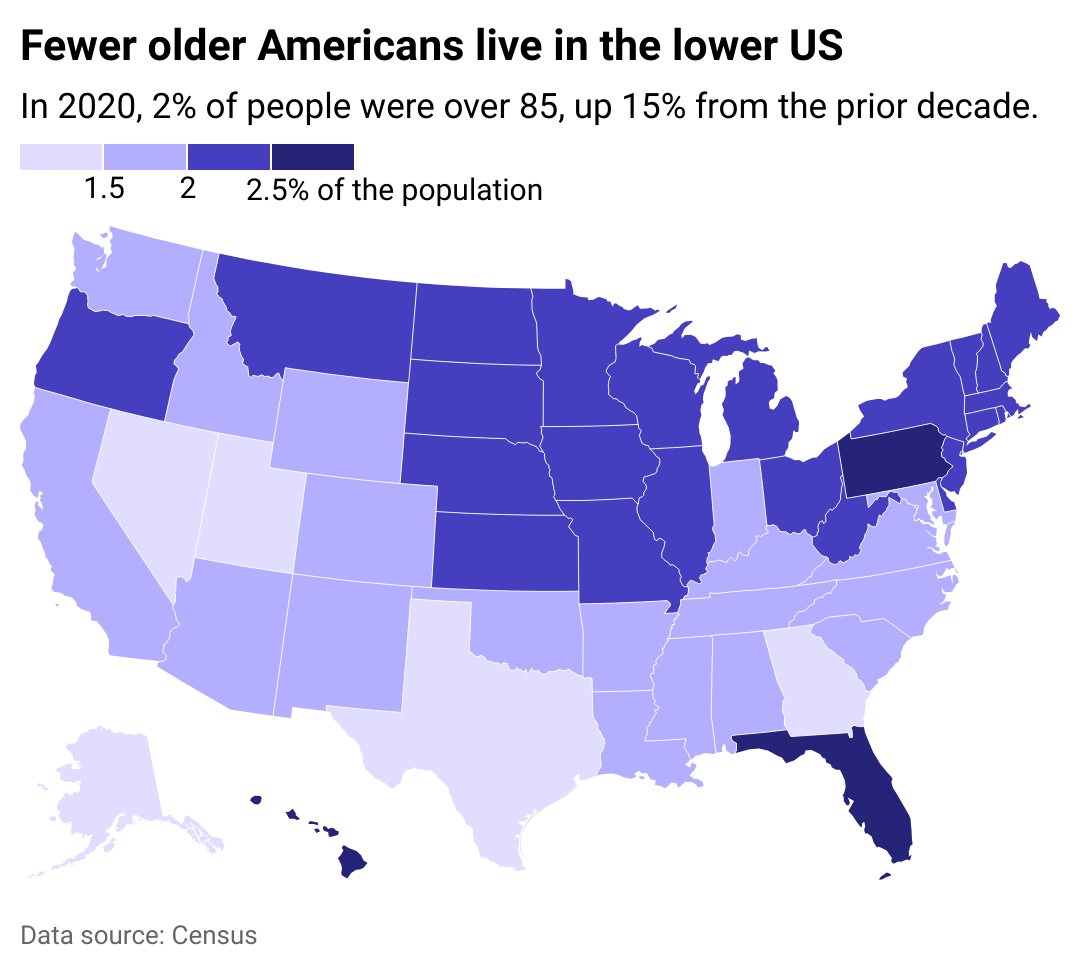As the US population ages, these states have the most older residents

Mark Rightmire/MediaNews Group/Orange County Register // Getty Images
As the US population ages, these states have the most older residents
A 111-year-old’s birthday cake with three lit number one candles.
Americans are living longer—and it’s changing the makeup of state and nationwide populations.
Northwell Health partnered with Stacker to examine the growing number of Americans aged 100 and over and how it breaks down by state. Over the last century, the proportion of Americans aged 65 and older has increased dramatically, from 1 in 20 in 1920 to 1 in 6 in 2020. The Population Reference Bureau says this trend is likely to continue as Census projections suggest the number of Americans 65 and above will increase by 47% by 2050.
As the aging population increases, so will centenarians. According to a 2024 Pew Research Center report, the number of Americans aged 100 or over is likely to quadruple by 2054 as baby boomers, those born between 1946 and 1964, enter retirement age.
Living to 100 was once extraordinarily rare, if not unheard of. Life expectancy in the U.S. was just 47.3 years old in 1900. It rose steadily for over a century until it peaked at 78.9 years in 2014 before declining in 2015, reaching 76.4 years in 2021. It crept up once again to 77.5 in 2022.
Since the onset of the COVID-19 pandemic, mortality gaps between white and Black Americans have widened, and the improvement in Hispanic longevity has disappeared.
![]()

Northwell Health
More Americans are living to 100
Column chart showing how the centenarian population spiked in 2020. The number of Americans 100 or older has grown 50% since 2010.
In 2020, there were 80,000 people over 100, an increase of around 50% since 2010. In an interview with USA Today in 2023, Thomas Perls, a professor of medicine at Boston University, noted that medical advances likely contributed to this increase: “Many more people who have the genetic makeup and environmental exposures that increase one’s chances of getting to 100, but who would have otherwise died of what are now readily reversible problems, are able to fulfill their survival destiny.”
The number of centenarians varies by state. According to 2022 Social Security Administration data, while highly populous states like Califonia, New York, and Florida have the most centenarians, Hawai’i had the highest percentage of over 100s in 2022 (0.24% of its total population), followed by Washington D.C. (0.2%) and Connecticut (0.19%).
Increased longevity varies among racial and ethnic backgrounds. According to the Pew report, 77% of those over 100 are white, while 8% are Black, 7% are Asian, and 6% are Hispanic. Less than 1% are multiracial, Native Hawaiian, Pacific Islander, Alaska Native, or Native American.
By 2054, the percentage of centenarians who are white or Asian is projected to decrease to 72% and 5%, respectively, whereas shares of those who are Hispanic and non-Hispanic Black are predicted to increase to 11% and 10%, respectively. Pew noted that in its analysis, racial groups represent non-Hispanic people of a single race while Hispanics may be any race.
The same report also revealed that 78% of centenarians were women, while 22% were men.
In 30 years however, the male centenarians are expected to increase to 32%, while female centenarians are projected to decrease to 68%. It’s important to note that Pew analyzed this data using a binary understanding of sex and gender, which excludes important information about nonbinary and transgender people.
There are several hypotheses as to why women tend to outlive men. One is the theory that some biological processes can help men at a young age but cause harm later in life, such as testosterone production, which promotes muscle strength and the creation of red blood cells. Those same processes can increase the risk of blood clot formation and associated conditions like heart disease and stroke as men age, according to a 2023 Boston University article by Perls.
While many older Americans today have improved function and are more likely to work than previous generations, many older adults still require care and support as their bodies age. A 2023 report from the Schwartz Center for Economic Policy Analysis notes that 20% of adults aged 55 and older struggled with one or more daily activities. Among those, 42% who have difficulty in daily tasks like getting dressed and using the toilet do not receive help. The report also revealed that unpaid family care is the most common form of assistance and that older adults without close family are especially vulnerable to going without care.
These numbers reflect the long-term care crisis in the U.S. A vast caregiving gap exists between those who need help and those who can receive it, which is exacerbated by expensive long-term care. The longer older adults live, the longer they may require care.

Northwell Health
Share of Americans over 85 on the rise
U.S. map showing fewer older Americans live in the lower U.S. In 2020, 2% of people were over 85, up 15% from the prior decade.
A significant increase in the number of Americans living to 85 is already underway, and some might be on their way to living a full century.
In 2020, 6.3 million Americans were over 85 years old, accounting for 1.9% of the total population. The Northeast and Midwest tended to have the highest shares of people aged 85 and older; these regions have a higher portion of older adults because young people often move south and west in pursuit of new opportunities, according to the PRB.
Florida was an exception, with 2.5%. Hawai’i and Pennsylvania also had high numbers of over 85s, at 2.6% and 2.5%, respectively. Conversely, states with the lowest percentage of adults over 85 years old included Utah, at 1.2%, and Alaska, at 0.9%. While the number of people over 85 has increased in all states since 2010, the largest growth was in Nevada (41.5%), Alaska (38.4%), and Texas (30%).
The reasons for these shifting demographics vary among states. In Alaska, for example, low birth rates and higher rates of out-migration than in-migration also contribute to the state’s older population, according to a 2023 U.S. News report. States such as Nevada, New Mexico, and South Carolina have relatively larger proportions of older Americans. They tend to attract retirees due to the significantly lower cost of living than the rest of the country.
As for the secret to a long life, that’s anyone’s guess. However, those who’ve made it to triple digits have a few suggestions: Surround yourself with loved ones, keep walking, see the glass half full, and take care of your health in body and mind.
Story editing by Elsie Drexler and Alizah Salario. Additional editing by Kelly Glass. Copy editing by Kristen Wegrzyn.
This story originally appeared on Northwell Health and was produced and
distributed in partnership with Stacker Studio.